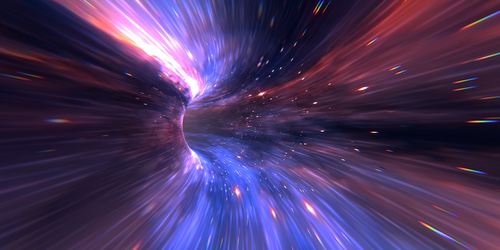Wormholes Could Be Hiding in Plain Sight
In movies and TV shows, wormholes are typically depicted as tunnels that move travelers between two points in time and space. While long theorized (they were first predicted in 1916), these mystical objects have never been observed by scientists. Now researchers predict that wormholes could be hiding in plain sight [1]. Simulating the polarized light emissions for wormholes and black holes, Petya Nedkova and colleagues from Sofia University, Bulgaria, predict that there may be only slight differences in the spectra of the polarized light emanating from a traversable wormhole and from a black hole.
Nedkova and colleagues studied a hypothetical static, traversable wormhole—one that doesn’t evolve or rotate. They simulated the light emitted directly by the disk surrounding this wormhole, analyzing its polarization. The researchers then created an image of this polarized light. They also created indirect images of the wormhole using polarized light lensed by the object.
Comparing the direct wormhole image to one showing the polarized light emitted by the disk surrounding a static black hole, the team found that its images were nearly identical, with the polarization intensity and direction differing by less than 4%. However, the indirect images were distinguishable—the polarization patterns were similar, but the observable radii of the objects were considerably different. The polarization intensities of wormholes were also an order of magnitude greater in the indirect images than those of black holes.
Nedkova says that the team now plans to look for other signals that could help distinguish black holes and wormholes but that don’t require the precise observations needed for spotting the polarization effects. Some of the measurements would require a level of precision current telescopes cannot achieve. “We will look for something that will tell us the difference more easily,” says Nedkova.
–Allison Gasparini
Allison Gasparini is a freelance science writer based in Santa Cruz, CA.
References
- V. Deliyski et al., “Polarized image of equatorial emission in horizonless spacetimes: Traversable wormholes,” Phys. Rev. D 106, 104024 (2022).




